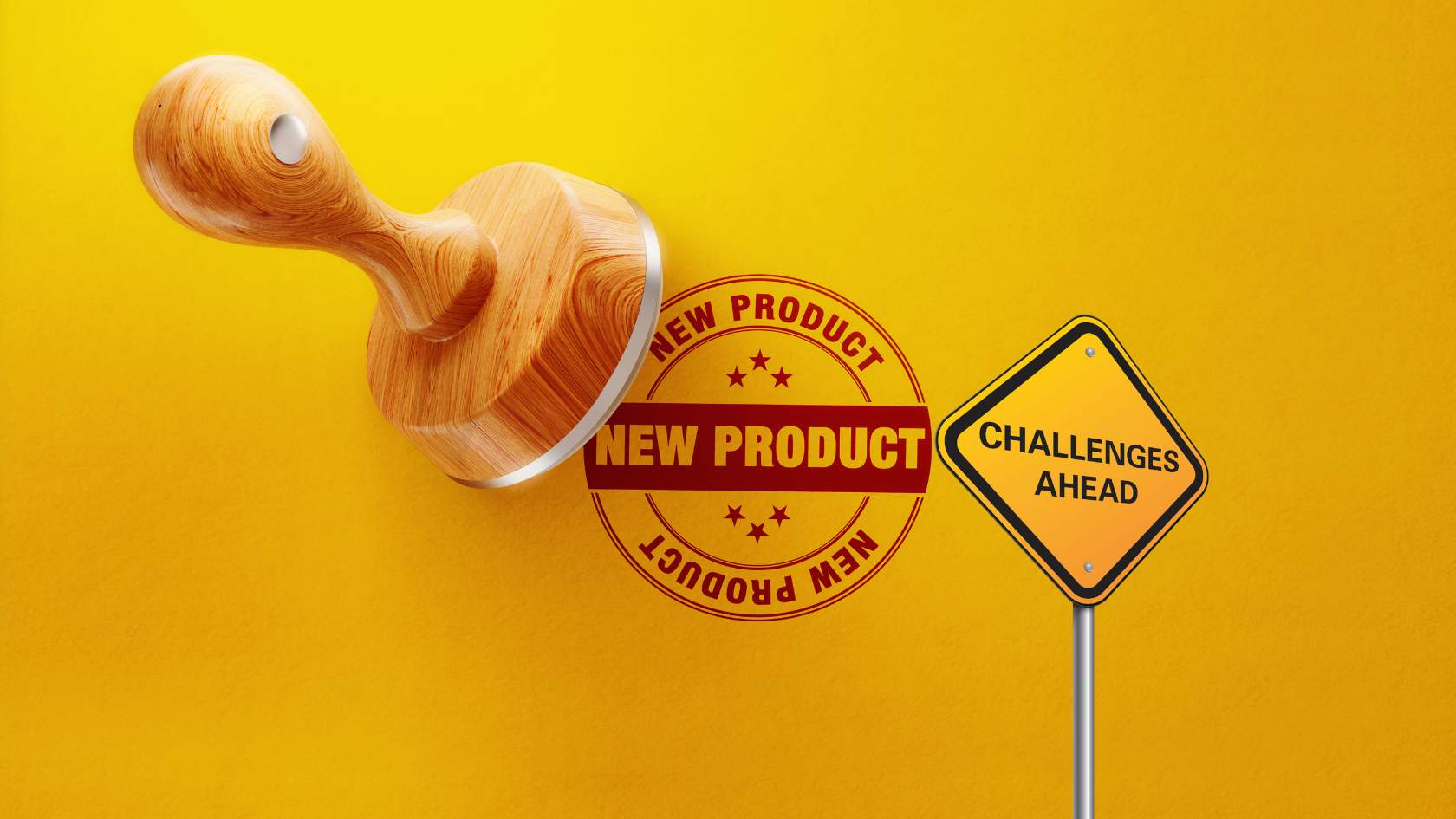Why do some products take off while others never make it past the planning stage? Product Development Challenges can slow down or even stop a great idea from becoming a reality. Businesses often face issues like unclear goals, limited resources, and last-minute changes.
Table of Contents
Without a structured approach, even the best ideas can fail. Whether you’re launching a startup or improving an existing product, understanding these hurdles is key. In this blog, we’ll look at the most common challenges and how to tackle them effectively.
What is Product Development?
New product development focuses on building new products or improving current ones. It starts with an idea and involves steps like planning, designing, and testing to turn that idea into something real. The goal is to make something people want or need and that works well.
The process usually includes researching what customers want, coming up with designs, and building a prototype. A prototype is a sample or early version of the product to see how it works. Feedback from testing helps fix problems and make the product better before it’s sold.
Finally, once the product is ready, it’s made in larger quantities and sold to customers. Companies also keep improving the product based on what users say or if new ideas come up. Product development is about creating useful, high-quality things that solve problems or make life easier.
Steps of New Product Development
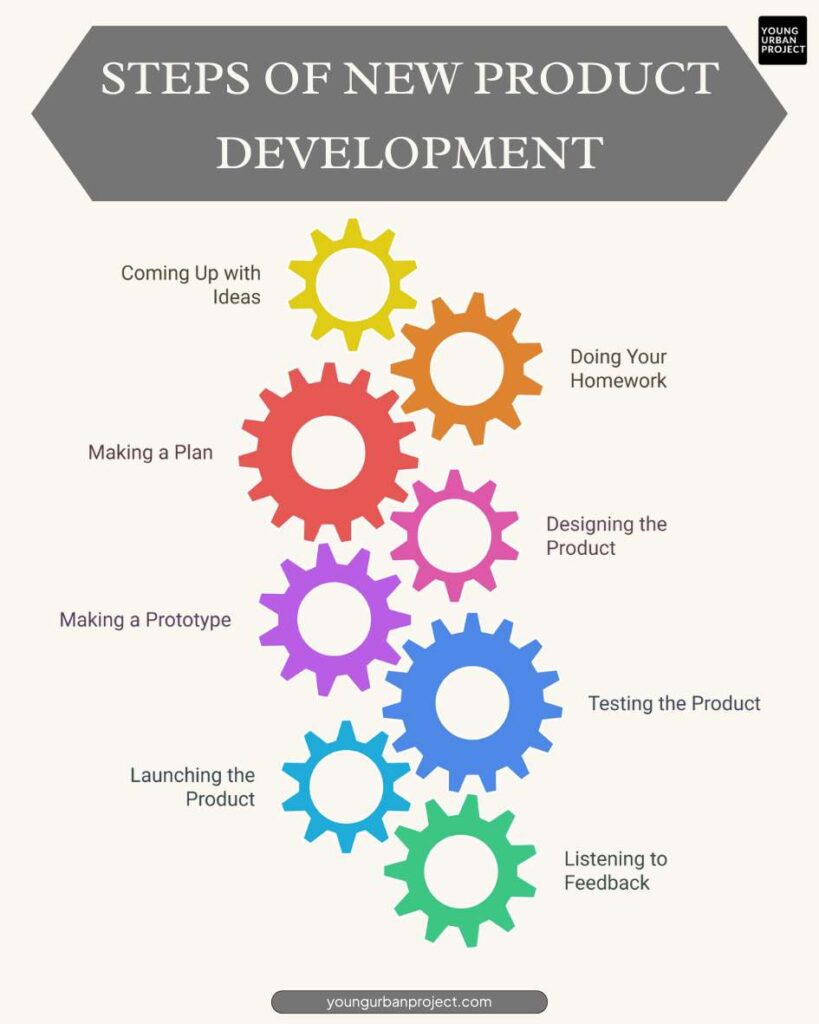
1. Coming Up with Ideas
This is where it all starts. You sit down and think, “What can I make that people will love?” Ideas can come from anywhere:
- Maybe your friend complains about how hard it is to find a good water bottle.
- Or your team brainstorms and thinks, “Hey, what if we made a phone case that charges your phone?”
- You might also look at what’s trending. For example, if everyone’s into fitness, you might think of a new workout gadget.
The key is to find a problem people have and come up with a product that solves it or makes life easier. It’s like being a detective—you’re looking for clues about what people need.
2. Doing Your Homework
Once you have an idea, you need to check if it’s worth your time and effort. This step is all about research:
- Ask People: Talk to potential customers. Do they actually want this product? Would they buy it?
- Check the Competition: Look at what’s already out there. If someone’s already selling something similar, how can you make yours better or different?
- Understand the Market: Is there enough demand for your product? Are people willing to pay for it?
This step helps you avoid wasting time on an idea that might not work. For example, if you find out that 10 companies already sell the same thing, you might need to tweak your idea to stand out.
3. Making a Plan
If your idea passes the research test, it’s time to plan how to bring it to life. This step is like drawing a map for your journey:
- Budget: Figure out how much money you’ll need. Will you need to hire people, buy materials, or rent equipment?
- Timeline: Decide how long it will take. When do you want to launch the product?
- Resources: What tools, materials, or team members will you need?
A good plan keeps you organized and helps you avoid surprises later. For example, if you know you’ll need $10,000 and six months to make the product, you can prepare accordingly.
4. Designing the Product
Now comes the fun part—designing in product development! This is where you turn your idea into something real. You might:
- Create a rough visual representation of the product.
- Use a good 3-D Modeling software to create a 3D model.
- Think about how people will use it. Is it easy to hold? Does it look good?
The design should be both functional and attractive. For example, if you’re designing a coffee mug, you’ll think about how it feels in your hand, how easy it is to clean, and how nice it looks on a table.
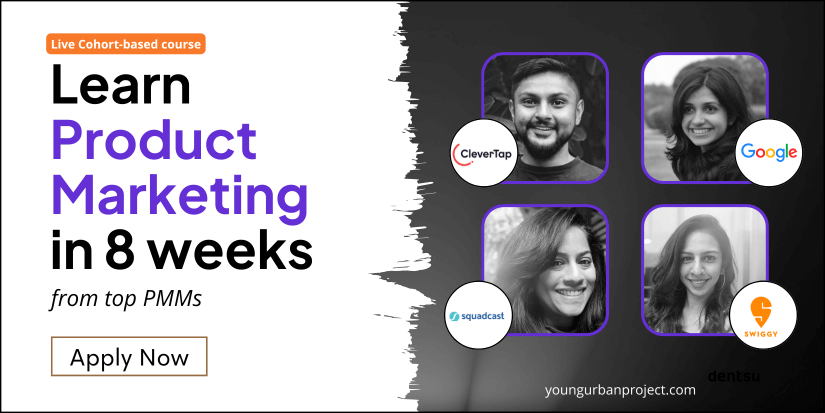
Checkout our Product Marketing Course
5. Making a Prototype
In product development, a prototype is a testable first attempt at your product—imperfect but functional for testing. For example:
- If you’re making a new bag, you might sew a sample by hand.
- If it’s an app, you might create a basic version to test the features.
The goal is to see if your design works in real life. You might notice things you didn’t think about before, like “This handle is too small” or “This button is hard to press.” Prototyping helps you fix those issues before making the final product.
6. Testing the Product
Once you have a prototype, it’s time to test it with real people. This step during product development is super important because it helps you find out what works and what doesn’t. You might:
- Give the product to a group of people and watch how they use it.
- Ask for their honest feedback. Do they like it? Is there anything they’d change?
Testing ensures the product is safe, works well, and meets customer needs. For example, if people say the app crashes a lot, you can fix the bugs before launching it.
7. Launching the Product
After testing and fixing any issues, your product is ready to go out into the world! This step is all about getting it into the hands of customers. You’ll need to:
- Market It: Let people know about your product. You might run ads, post on social media, or host a launch event.
- Sell It: Decide where and how people can buy it. Will it be online, in stores, or both?
The launch is exciting because it’s the moment all your hard work pays off. For example, if you’ve made a new type of notebook, you might create a website, post videos about it, and send samples to influencers.
Also read: 10 Creative Product Launch Ideas
8. Listening to Feedback
Once the product development is finished and the product is out there, your job isn’t over. You need to listen to what customers are saying. This step is about learning and improving:
- What’s Working: Are people loving the product? What do they like about it?
- What’s Not: Are there any complaints or suggestions for improvement?
Feedback helps you make the product even better over time. For example, if customers say they want a bigger size or a new color, you can add those options in the future.
Also read: Benefits of Product Management Bootcamps
Most Common Product Development Challenges
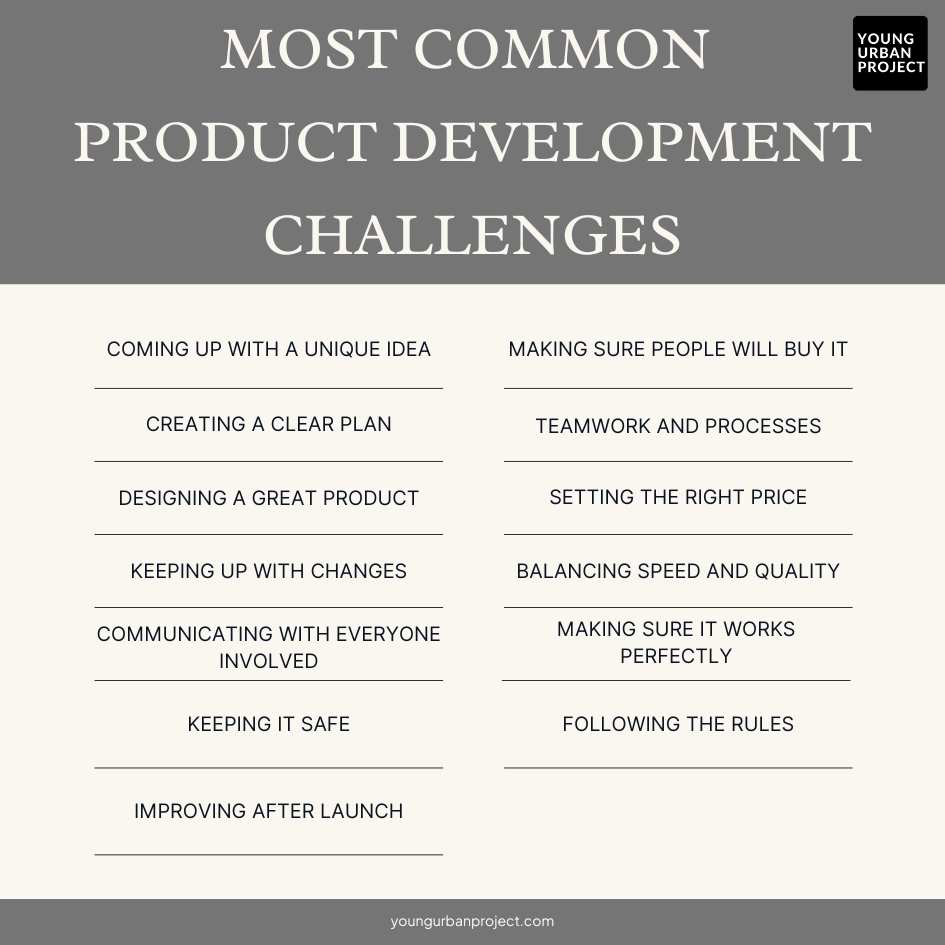
1. Coming Up with a Unique Idea
There are numerous product development challenges, but the one that bugs product folks the most is coming up with a new idea. It’s tough to think of something new because there are already so many products out there. You need an idea that solves a problem in a fresh way or makes life better for people.
But creativity doesn’t always come easy, and it’s hard to make sure your idea is both original and actually useful. Sometimes, it feels like there’s nothing original left to discover!
2. Making Sure People Will Buy It
Even if you have a great idea, you need to make sure people actually want it. This means understanding your customers, what they need, what they like, and how much they’re willing to pay.
If you build something no one wants, it won’t sell. Your whole product development process will be a waste. Talking to potential customers and researching the market is important, but it’s not always easy to figure out what people really want.
3. Creating a Clear Plan
A roadmap is like a step-by-step guide for building your product. If the plan isn’t clear or well thought out, things can get messy. You might miss important steps, set deadlines that are too tight, or forget to include key features. A bad plan can lead to delays, confusion, and even failure to finish the product.
4. Teamwork and Processes
Workflow is how your team works together to get things done. If the process isn’t smooth, things can slow down or go wrong. For example, if team members don’t communicate well, tasks might get repeated or forgotten. If the process is too complicated, it can waste time. Good teamwork and clear processes are essential, but they’re not always easy to achieve.
5. Designing a Great Product
Designing a product that looks good, works well, and is easy to use is harder than it sounds. You need to balance how well it works with how enjoyable it is to use. If the design is too complicated, people might not want to use it. A solution that’s too simple may not accomplish enough. Finding the right balance is tricky but super important.
Also read: Building a Product Launch Plan for New Product Marketers
6. Setting the Right Price
Deciding how much to charge for your product is a big challenge. If you charge too much, people might not buy it. Setting your prices too low may prevent you from achieving the revenue you need. You need to think about how much it costs to make the product, what customers are willing to pay, and what your competitors are charging. Getting this balance right is hard but very important.
7. Keeping Up with Changes
Technology and trends change fast. What’s popular today might be outdated tomorrow. Keeping up with these changes and making sure your product stays relevant is a constant challenge. You need to be flexible and ready to adapt, but this can be stressful and expensive.
8. Balancing Speed and Quality
Getting your product to customers quickly is important, but you can’t rush so much that the quality suffers. If you take too long, competitors might beat you to the market. If you move too fast, the product might have bugs or missing features. Finding the right balance between speed and quality is a big challenge.
9. Stakeholder Communication
Stakeholders are people who have an interest in your product, like team members, investors, or partners. If you don’t communicate clearly with them, misunderstandings can happen. For example, investors might expect something different from what you’re building, or team members might not know what they’re supposed to do. Good communication is key, but it’s not always easy to keep everyone on the same page.
10. Making Sure It Works Perfectly
Before launching your product, you need to test it thoroughly to find and fix any problems. If you skip this step, customers might get a product that doesn’t work well, which can hurt your reputation. Testing takes time and effort, but it’s crucial for success.
11. Keeping It Safe
If your product involves technology, like an app or software, you need to protect it from hackers and cyber threats. A security breach can lead to stolen data, lost trust, and legal problems. Making sure your product is secure is a big challenge, especially as hackers keep finding new ways to break in.
12. Following the Rules
There are many laws and regulations you need to follow when creating a product. For example, if you’re selling a medical device, it needs to meet health and safety standards. If you’re collecting customer data, you need to follow privacy laws. Understanding and following these rules can be complicated and time-consuming.
13. Improving After Launch
Launching your product is just the beginning. After it’s out in the market, you need to listen to customer feedback and keep improving it. This might mean fixing bugs, adding new features, or making it easier to use. If you stop improving, customers might lose interest or switch to a competitor. Continuous improvement is essential but requires ongoing effort.
Also read: Customer-Centric Product Development
How to Overcome Product Development Challenges
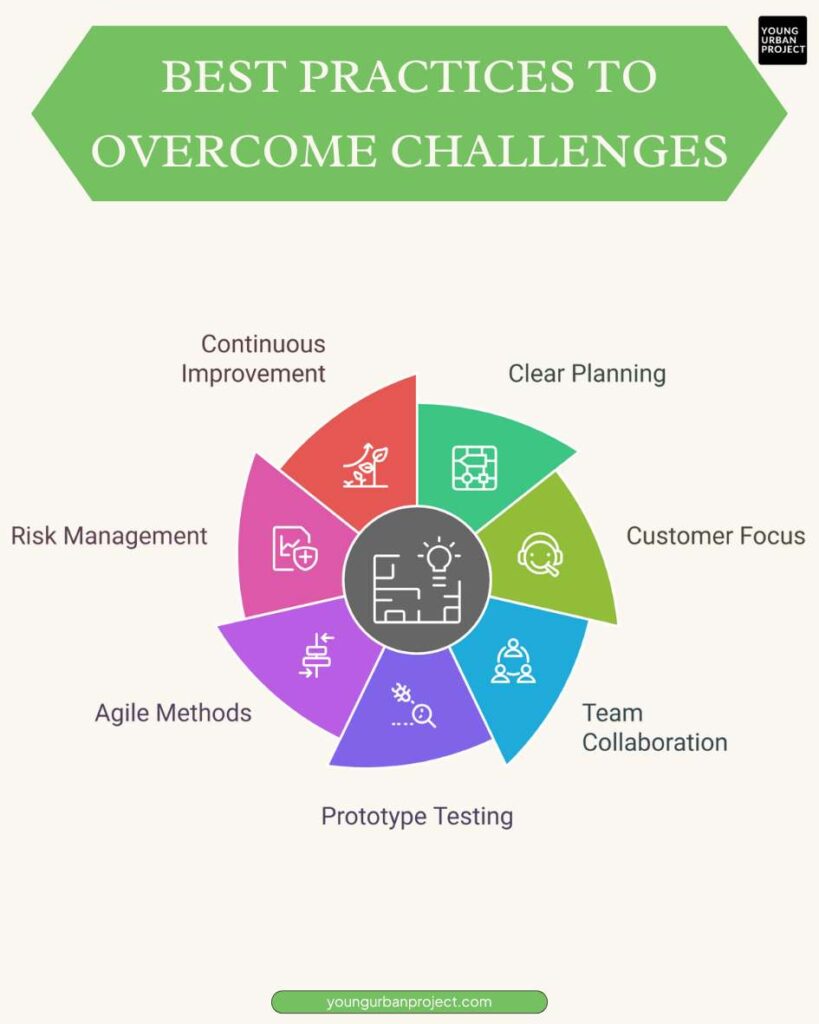
1. Clear Planning
A detailed roadmap is like a blueprint for your product. It should include:
- Goals: What you want to achieve with the product.
- Timelines: When each step or feature needs to be completed.
- Responsibilities: Who is in charge of each task?
Why it helps:
- Helps avoid mix-ups and keeps everyone in sync.
- Helps avoid delays by setting realistic deadlines.
- Makes it easier to track progress and fix issues early.
Example: If you’re building an app, your roadmap might include steps like research, design, coding, testing, and launch, with clear deadlines for each.
2. Customer Focus
Your product should solve real problems for real people. To make sure it does:
- Talk to customers: Ask them what they need and what they like or dislike about similar products.
- Test ideas: Share early concepts or prototypes with customers to get their feedback.
- Iterate: Use their feedback to improve the product.
Why it helps:
- Ensures your product is something people actually want.
- Reduces the risk of building something that doesn’t sell.
- Builds customer loyalty because they feel heard and valued.
Example: If you’re designing a new coffee maker, ask coffee lovers what features they’d like (e.g., programmable settings, easy cleaning).
3. Team Collaboration
Good teamwork is essential for smooth product development. To improve collaboration:
- Communicate openly: Share updates, challenges, and ideas regularly.
- Define roles: Make sure everyone knows what they’re responsible for.
- Use tools: Tools like Slack, Trello, or Asana can help teams stay organized.
Why it helps:
- Prevents misunderstandings and duplicated work.
- Speeds up the process by keeping everyone aligned.
- Encourages creativity and problem-solving through teamwork.
Example: If the design team and engineering team work closely, they can solve problems faster and avoid last-minute changes.
4. Prototype Testing
A prototype is an early version of your product. Testing it early helps you:
- Find problems: Catch design flaws or functionality issues before they become big problems.
- Save money: Fixing issues early is cheaper than fixing them later.
- Get feedback: Show the prototype to users and see how they interact with it.
Why it helps:
- Ensures the product works as intended.
- Reduces the risk of launching a product with major flaws.
- Builds confidence in the final product.
Example: If you’re building a website, test a basic version with real users to see if they can navigate it easily.
5. Agile Methods
Agile is a flexible way of working that focuses on:
- Small steps: Break the project into smaller tasks or features.
- Frequent updates: Release small improvements regularly instead of waiting for a big launch.
- Adaptability: Be ready to change plans based on feedback or new information.
Why it helps:
- Makes it easier to respond to changes in the market or customer needs.
- Reduces the risk of wasting time on features people don’t want.
- Keeps the team motivated by delivering results quickly.
Example: Instead of building an entire app at once, release a basic version first, then add features like login, payment, etc., over time.
Also read: Agile vs Waterfall:Key Differences and Which One to Choose
6. Risk Management
Risks are potential problems that could derail your project. To manage them:
- Identify risks: Think about what could go wrong (e.g., delays, budget issues, technical problems).
- Plan solutions: Have a backup plan for each risk.
- Monitor risks: Keep an eye on potential issues and address them early.
Why it helps:
- Prevents small problems from becoming big disasters.
- Saves time and money by being prepared.
- Gives you peace of mind knowing you’re ready for challenges.
Example: If you’re worried about a key team member leaving, cross-train others so the project doesn’t stall.
7. Continuous Improvement
Your product isn’t finished after launch. To keep it successful:
- Listen to users: Pay attention to feedback and reviews.
- Fix issues: Address bugs or problems quickly.
- Add features: Keep improving the product based on what users want.
Why it helps:
- Keeps customers happy and loyal.
- Stays ahead of competitors by offering new and better features.
- Ensures the product stays relevant as trends and technology change.
Example: If users of your fitness app want a feature to track water intake, add it in the next update.
💡Conclusion
Bringing a new product to life is never a smooth journey. Every stage comes with unique challenges, from selecting the right idea to ensuring the final product meets quality standards. Businesses need to stay flexible and focus on problem-solving to overcome these difficulties. While budget constraints, time delays, and shifting customer demands are common, a well-structured approach helps minimize risks. By making smart decisions, using available resources wisely, and adapting to market needs, companies can improve their chances of success. In the end, a well-developed product is not just about innovation—it’s about delivering real value to customers.
FAQs: Product Development Ideas
1. How can I ensure idea selection is based on facts rather than personal opinions?
To ensure fair prioritization, use clear and measurable criteria like customer needs, market demand, and feasibility. Tools like scoring systems, weighted ranking, or team voting can help make the process objective. Involving multiple team members in the decision-making process also reduces bias and ensures the best ideas are chosen based on facts, not personal opinions.
2. What strategies can help when working with a very limited budget and resources?
When resources are tight, focus on the most critical tasks that add the most value. Use free or low-cost tools and software to save money. Collaborate with other teams or partners to share resources. Break the project into smaller, manageable steps and prioritize tasks that can be done quickly and efficiently. Being creative and flexible can help you achieve more with less.
3. What actions should I take if quality issues arise late in the development process?
If quality issues arise late, act quickly to identify the root cause of the problem. Assess whether it affects the entire product or just specific parts. Communicate openly with your team and stakeholders to find solutions. Adjust timelines if necessary to fix the issue without rushing. Conduct thorough testing to ensure the problem is resolved and the final product meets quality standards before launch.

